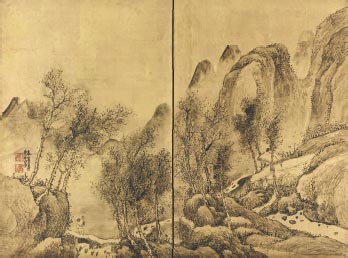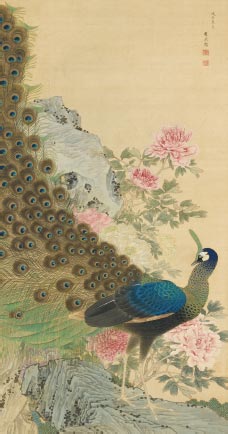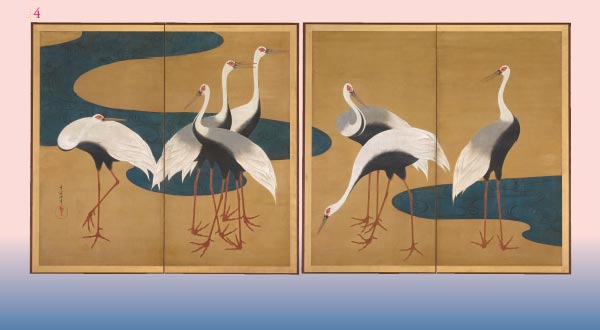 |
2
Landscape: “Lone Traveler
in Wintry Mountain”
By Yosa Buson
(1716–1783) Japan, Edo period, 18th century Two-panel screen, ink and gold foil on paper
This cold mountainous landscape with winter-withered trees
is a rare example of a work completely executed in ink on a
gold-leaf background by the great virtuoso of Japanese
literati painting, Yosa Buson. Buson frequently captured
landscapes with roads and rivers, which convey time
traversing and flowing by. Here, too, the motifs of the road
and river are used to express the vigorous passage of time.
|
 |
3
Peacock and Peonies
By Maruyama Ōkyo
(1733–1795) Japan, Edo period, dated Meiwa 5 (1768) Hanging scroll, color and ink on silk
Depicted here is a lone male peacock looking back at its
large raised tail. Ōkyo painted this work at age thirty-six,
during the early part of his career, when he ardently
reproduced early paintings and sketched figures and plants
under the patronage of Abbot Yūjō at Enman-in Temple. The
roundness and volume of the peacock, the craggy rocks, and
the soft, detailed petals of the peonies are all skillfully
rendered. The vibrant decorative scene is created through
the colorful feathers of the peacock, the blossoming large
peonies that surround this majestic bird, and the pale blue
Chinese scholar’s rock.
|
|
4 Cranes
By Suzuki Kiitsu
(1795–1858) Japan, Edo period, 19th century Pair of two-panel screens, color, ink, and gold foil on paper
Taking Ogata Kōrin’s folding screens of cranes as an
inspiration, Rinpa artists have successively painted folding
screens depicting a sedge of cranes and a stylized river on
gold background. The work here also emulates this Rinpa
motif with its gold background, its placement of the stream,
the spiral pattern of the water, and the form of the cranes.
However, compared to the Rinpa paintings, the direction of
the cranes and the position of their heads have been altered
and the composition exhibits a degree of freedom that cannot
be found in Kōrin’s original. The seal and signature
indicate that Kiitsu painted this piece in his late twenties
to early thirties, during which time he actively studied
Rinpa paintings, while boldly adding his own arrangements.
|
